Comprehensive Report on Health and Safety in Health & Social Care
VerifiedAdded on 2023/05/30
|11
|2278
|314
Report
AI Summary
This report provides a detailed overview of health and safety principles, hazards, and regulations within the health and social care sector. It covers various aspects, including electromagnetic field exposure, single fault conditions, leakage current, and proper insulation of electrical equipment. The re...
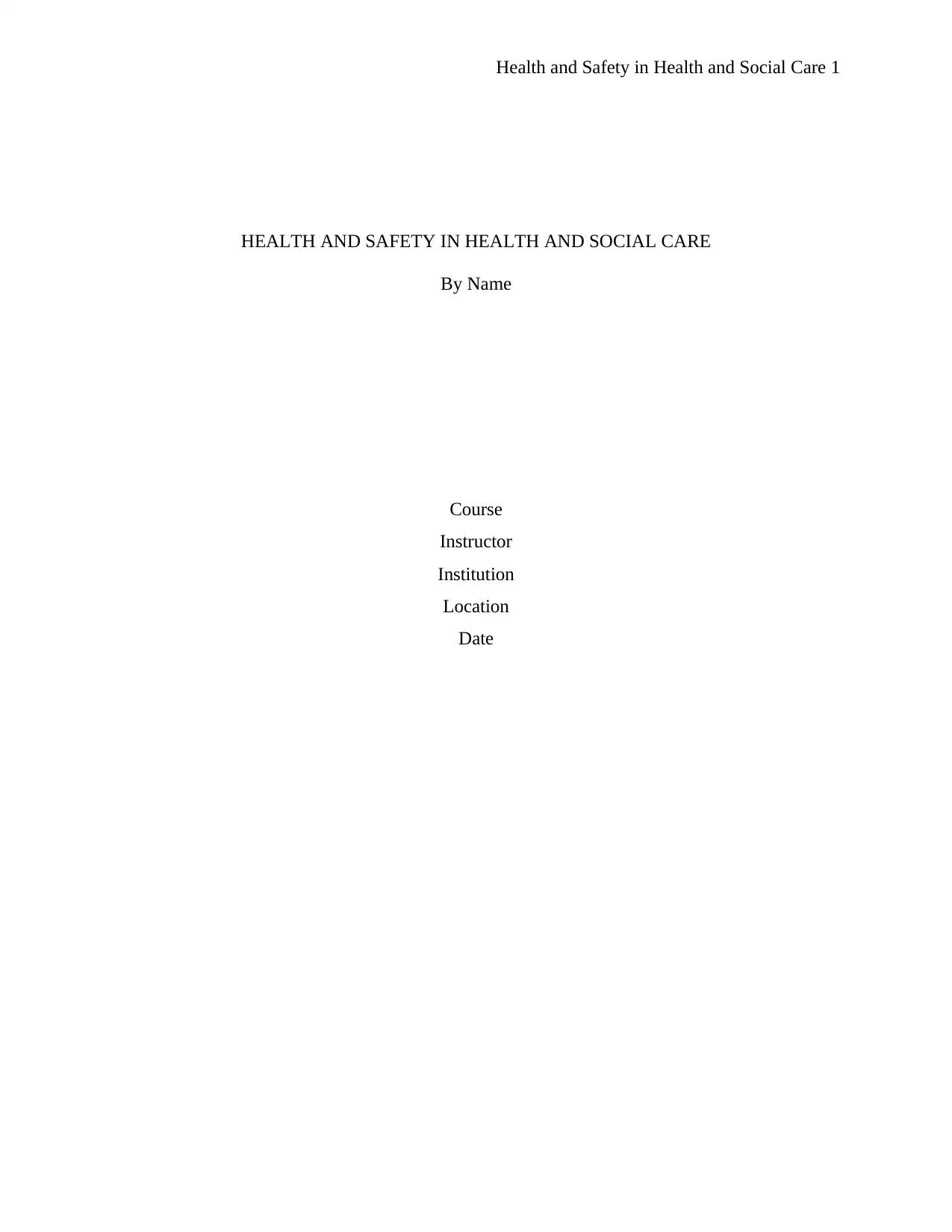
Health and Safety in Health and Social Care 1
HEALTH AND SAFETY IN HEALTH AND SOCIAL CARE
By Name
Course
Instructor
Institution
Location
Date
HEALTH AND SAFETY IN HEALTH AND SOCIAL CARE
By Name
Course
Instructor
Institution
Location
Date
Paraphrase This Document
Need a fresh take? Get an instant paraphrase of this document with our AI Paraphraser
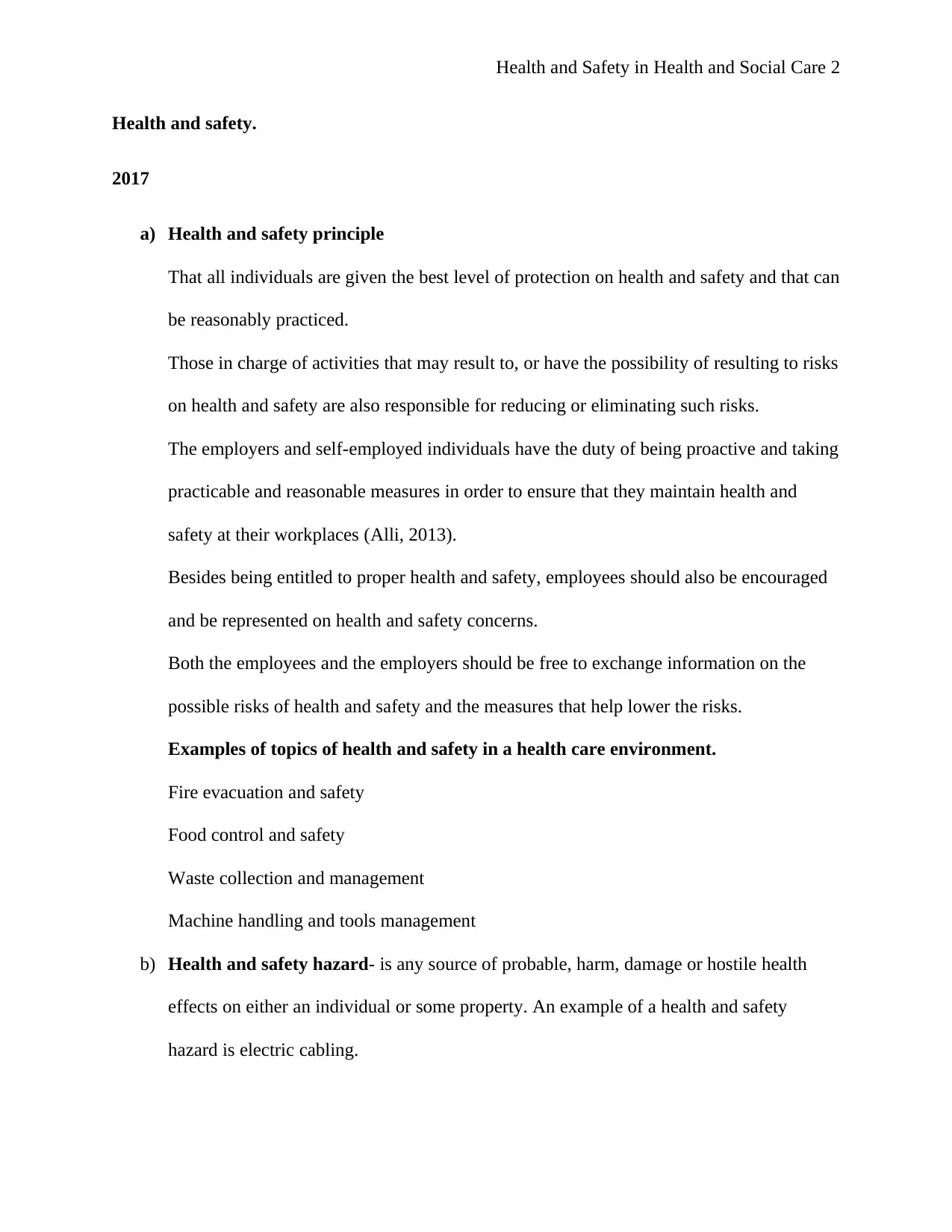
Health and Safety in Health and Social Care 2
Health and safety.
2017
a) Health and safety principle
That all individuals are given the best level of protection on health and safety and that can
be reasonably practiced.
Those in charge of activities that may result to, or have the possibility of resulting to risks
on health and safety are also responsible for reducing or eliminating such risks.
The employers and self-employed individuals have the duty of being proactive and taking
practicable and reasonable measures in order to ensure that they maintain health and
safety at their workplaces (Alli, 2013).
Besides being entitled to proper health and safety, employees should also be encouraged
and be represented on health and safety concerns.
Both the employees and the employers should be free to exchange information on the
possible risks of health and safety and the measures that help lower the risks.
Examples of topics of health and safety in a health care environment.
Fire evacuation and safety
Food control and safety
Waste collection and management
Machine handling and tools management
b) Health and safety hazard- is any source of probable, harm, damage or hostile health
effects on either an individual or some property. An example of a health and safety
hazard is electric cabling.
Health and safety.
2017
a) Health and safety principle
That all individuals are given the best level of protection on health and safety and that can
be reasonably practiced.
Those in charge of activities that may result to, or have the possibility of resulting to risks
on health and safety are also responsible for reducing or eliminating such risks.
The employers and self-employed individuals have the duty of being proactive and taking
practicable and reasonable measures in order to ensure that they maintain health and
safety at their workplaces (Alli, 2013).
Besides being entitled to proper health and safety, employees should also be encouraged
and be represented on health and safety concerns.
Both the employees and the employers should be free to exchange information on the
possible risks of health and safety and the measures that help lower the risks.
Examples of topics of health and safety in a health care environment.
Fire evacuation and safety
Food control and safety
Waste collection and management
Machine handling and tools management
b) Health and safety hazard- is any source of probable, harm, damage or hostile health
effects on either an individual or some property. An example of a health and safety
hazard is electric cabling.
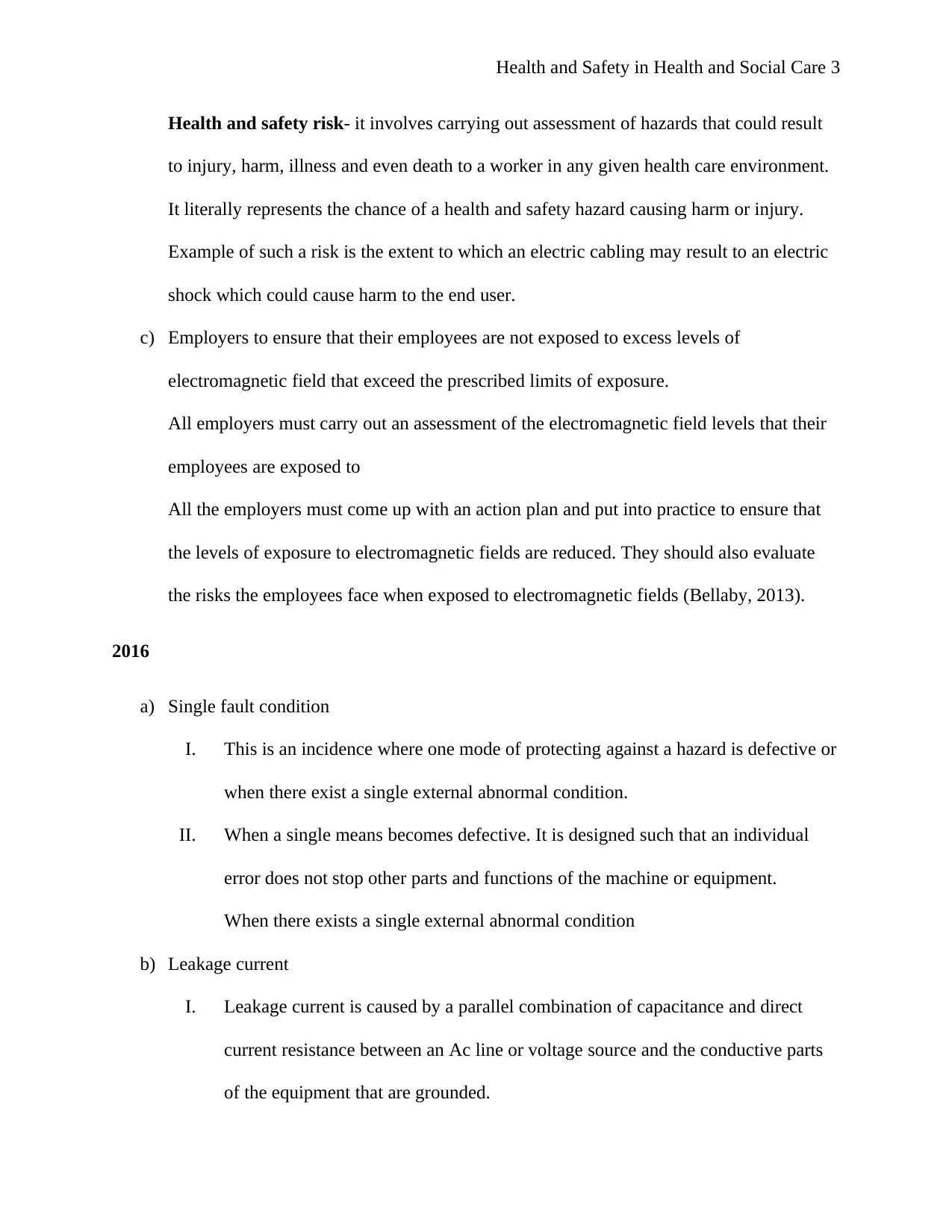
Health and Safety in Health and Social Care 3
Health and safety risk- it involves carrying out assessment of hazards that could result
to injury, harm, illness and even death to a worker in any given health care environment.
It literally represents the chance of a health and safety hazard causing harm or injury.
Example of such a risk is the extent to which an electric cabling may result to an electric
shock which could cause harm to the end user.
c) Employers to ensure that their employees are not exposed to excess levels of
electromagnetic field that exceed the prescribed limits of exposure.
All employers must carry out an assessment of the electromagnetic field levels that their
employees are exposed to
All the employers must come up with an action plan and put into practice to ensure that
the levels of exposure to electromagnetic fields are reduced. They should also evaluate
the risks the employees face when exposed to electromagnetic fields (Bellaby, 2013).
2016
a) Single fault condition
I. This is an incidence where one mode of protecting against a hazard is defective or
when there exist a single external abnormal condition.
II. When a single means becomes defective. It is designed such that an individual
error does not stop other parts and functions of the machine or equipment.
When there exists a single external abnormal condition
b) Leakage current
I. Leakage current is caused by a parallel combination of capacitance and direct
current resistance between an Ac line or voltage source and the conductive parts
of the equipment that are grounded.
Health and safety risk- it involves carrying out assessment of hazards that could result
to injury, harm, illness and even death to a worker in any given health care environment.
It literally represents the chance of a health and safety hazard causing harm or injury.
Example of such a risk is the extent to which an electric cabling may result to an electric
shock which could cause harm to the end user.
c) Employers to ensure that their employees are not exposed to excess levels of
electromagnetic field that exceed the prescribed limits of exposure.
All employers must carry out an assessment of the electromagnetic field levels that their
employees are exposed to
All the employers must come up with an action plan and put into practice to ensure that
the levels of exposure to electromagnetic fields are reduced. They should also evaluate
the risks the employees face when exposed to electromagnetic fields (Bellaby, 2013).
2016
a) Single fault condition
I. This is an incidence where one mode of protecting against a hazard is defective or
when there exist a single external abnormal condition.
II. When a single means becomes defective. It is designed such that an individual
error does not stop other parts and functions of the machine or equipment.
When there exists a single external abnormal condition
b) Leakage current
I. Leakage current is caused by a parallel combination of capacitance and direct
current resistance between an Ac line or voltage source and the conductive parts
of the equipment that are grounded.
⊘ This is a preview!⊘
Do you want full access?
Subscribe today to unlock all pages.

Trusted by 1+ million students worldwide
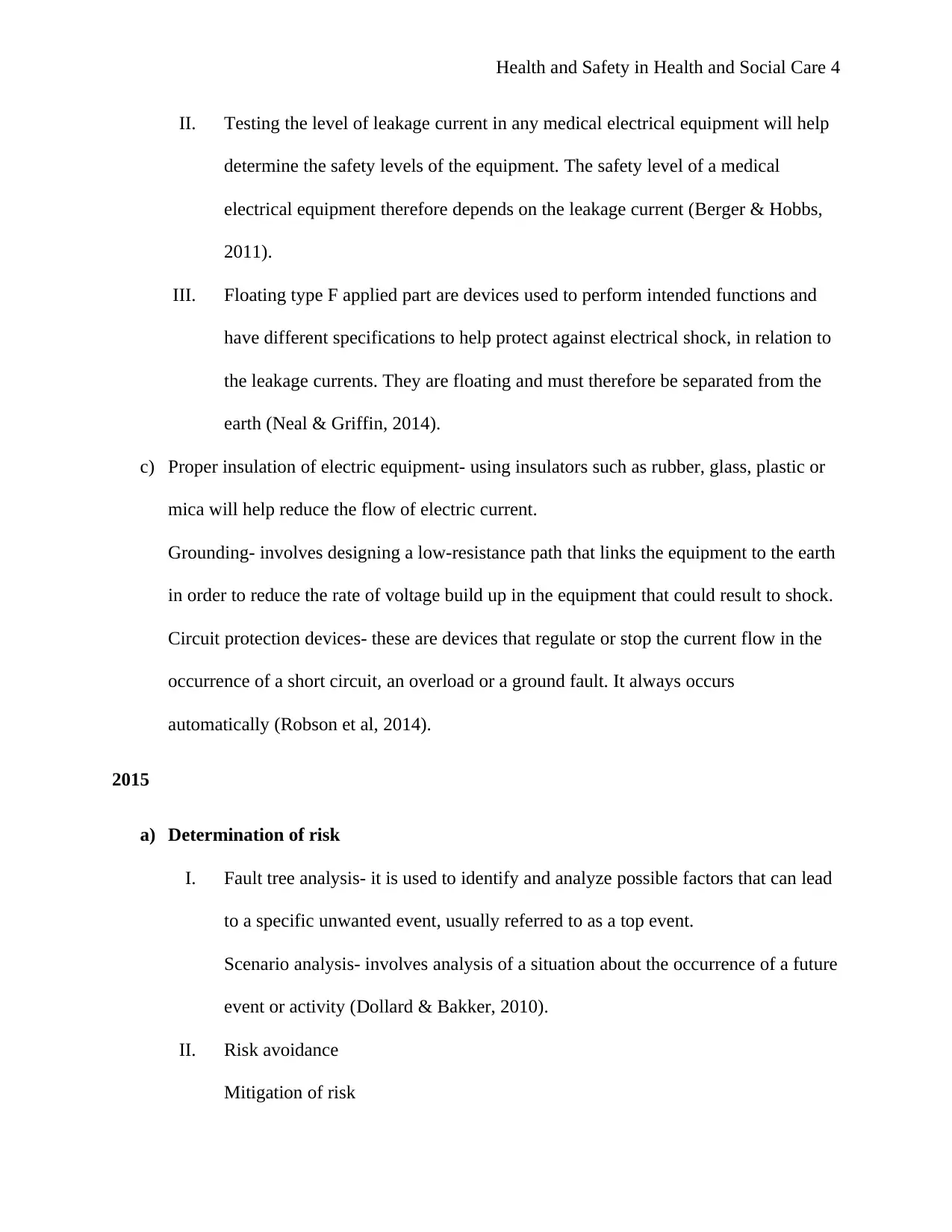
Health and Safety in Health and Social Care 4
II. Testing the level of leakage current in any medical electrical equipment will help
determine the safety levels of the equipment. The safety level of a medical
electrical equipment therefore depends on the leakage current (Berger & Hobbs,
2011).
III. Floating type F applied part are devices used to perform intended functions and
have different specifications to help protect against electrical shock, in relation to
the leakage currents. They are floating and must therefore be separated from the
earth (Neal & Griffin, 2014).
c) Proper insulation of electric equipment- using insulators such as rubber, glass, plastic or
mica will help reduce the flow of electric current.
Grounding- involves designing a low-resistance path that links the equipment to the earth
in order to reduce the rate of voltage build up in the equipment that could result to shock.
Circuit protection devices- these are devices that regulate or stop the current flow in the
occurrence of a short circuit, an overload or a ground fault. It always occurs
automatically (Robson et al, 2014).
2015
a) Determination of risk
I. Fault tree analysis- it is used to identify and analyze possible factors that can lead
to a specific unwanted event, usually referred to as a top event.
Scenario analysis- involves analysis of a situation about the occurrence of a future
event or activity (Dollard & Bakker, 2010).
II. Risk avoidance
Mitigation of risk
II. Testing the level of leakage current in any medical electrical equipment will help
determine the safety levels of the equipment. The safety level of a medical
electrical equipment therefore depends on the leakage current (Berger & Hobbs,
2011).
III. Floating type F applied part are devices used to perform intended functions and
have different specifications to help protect against electrical shock, in relation to
the leakage currents. They are floating and must therefore be separated from the
earth (Neal & Griffin, 2014).
c) Proper insulation of electric equipment- using insulators such as rubber, glass, plastic or
mica will help reduce the flow of electric current.
Grounding- involves designing a low-resistance path that links the equipment to the earth
in order to reduce the rate of voltage build up in the equipment that could result to shock.
Circuit protection devices- these are devices that regulate or stop the current flow in the
occurrence of a short circuit, an overload or a ground fault. It always occurs
automatically (Robson et al, 2014).
2015
a) Determination of risk
I. Fault tree analysis- it is used to identify and analyze possible factors that can lead
to a specific unwanted event, usually referred to as a top event.
Scenario analysis- involves analysis of a situation about the occurrence of a future
event or activity (Dollard & Bakker, 2010).
II. Risk avoidance
Mitigation of risk
Paraphrase This Document
Need a fresh take? Get an instant paraphrase of this document with our AI Paraphraser
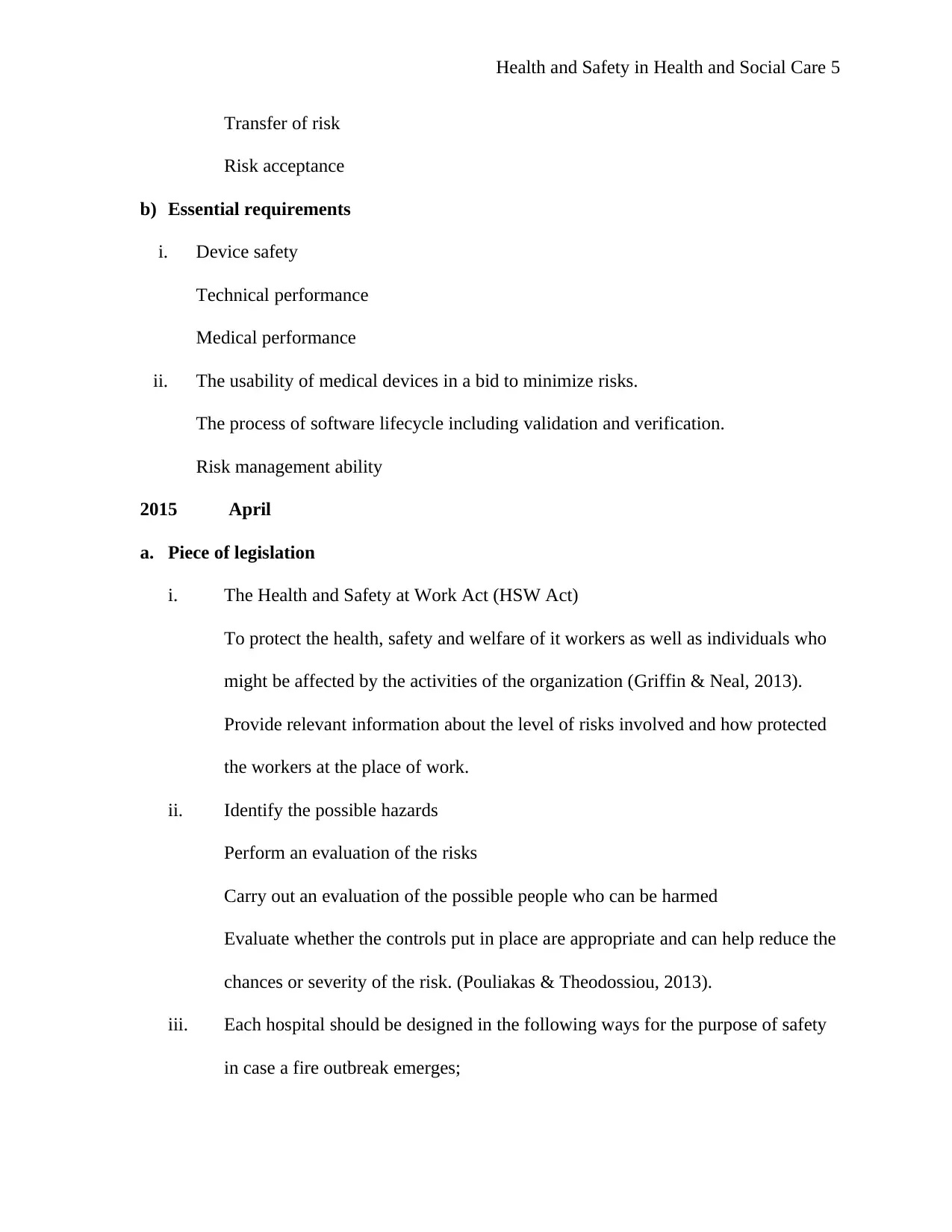
Health and Safety in Health and Social Care 5
Transfer of risk
Risk acceptance
b) Essential requirements
i. Device safety
Technical performance
Medical performance
ii. The usability of medical devices in a bid to minimize risks.
The process of software lifecycle including validation and verification.
Risk management ability
2015 April
a. Piece of legislation
i. The Health and Safety at Work Act (HSW Act)
To protect the health, safety and welfare of it workers as well as individuals who
might be affected by the activities of the organization (Griffin & Neal, 2013).
Provide relevant information about the level of risks involved and how protected
the workers at the place of work.
ii. Identify the possible hazards
Perform an evaluation of the risks
Carry out an evaluation of the possible people who can be harmed
Evaluate whether the controls put in place are appropriate and can help reduce the
chances or severity of the risk. (Pouliakas & Theodossiou, 2013).
iii. Each hospital should be designed in the following ways for the purpose of safety
in case a fire outbreak emerges;
Transfer of risk
Risk acceptance
b) Essential requirements
i. Device safety
Technical performance
Medical performance
ii. The usability of medical devices in a bid to minimize risks.
The process of software lifecycle including validation and verification.
Risk management ability
2015 April
a. Piece of legislation
i. The Health and Safety at Work Act (HSW Act)
To protect the health, safety and welfare of it workers as well as individuals who
might be affected by the activities of the organization (Griffin & Neal, 2013).
Provide relevant information about the level of risks involved and how protected
the workers at the place of work.
ii. Identify the possible hazards
Perform an evaluation of the risks
Carry out an evaluation of the possible people who can be harmed
Evaluate whether the controls put in place are appropriate and can help reduce the
chances or severity of the risk. (Pouliakas & Theodossiou, 2013).
iii. Each hospital should be designed in the following ways for the purpose of safety
in case a fire outbreak emerges;
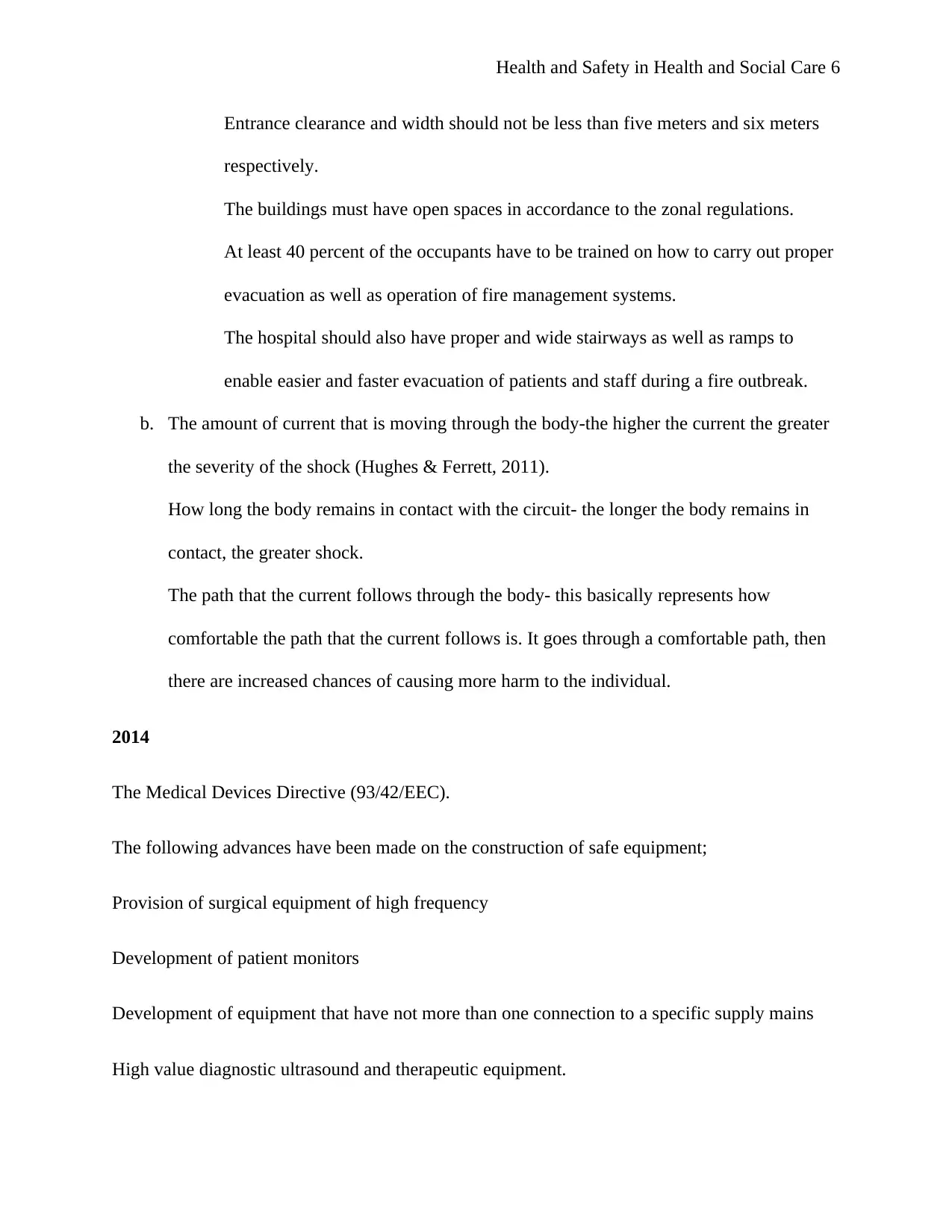
Health and Safety in Health and Social Care 6
Entrance clearance and width should not be less than five meters and six meters
respectively.
The buildings must have open spaces in accordance to the zonal regulations.
At least 40 percent of the occupants have to be trained on how to carry out proper
evacuation as well as operation of fire management systems.
The hospital should also have proper and wide stairways as well as ramps to
enable easier and faster evacuation of patients and staff during a fire outbreak.
b. The amount of current that is moving through the body-the higher the current the greater
the severity of the shock (Hughes & Ferrett, 2011).
How long the body remains in contact with the circuit- the longer the body remains in
contact, the greater shock.
The path that the current follows through the body- this basically represents how
comfortable the path that the current follows is. It goes through a comfortable path, then
there are increased chances of causing more harm to the individual.
2014
The Medical Devices Directive (93/42/EEC).
The following advances have been made on the construction of safe equipment;
Provision of surgical equipment of high frequency
Development of patient monitors
Development of equipment that have not more than one connection to a specific supply mains
High value diagnostic ultrasound and therapeutic equipment.
Entrance clearance and width should not be less than five meters and six meters
respectively.
The buildings must have open spaces in accordance to the zonal regulations.
At least 40 percent of the occupants have to be trained on how to carry out proper
evacuation as well as operation of fire management systems.
The hospital should also have proper and wide stairways as well as ramps to
enable easier and faster evacuation of patients and staff during a fire outbreak.
b. The amount of current that is moving through the body-the higher the current the greater
the severity of the shock (Hughes & Ferrett, 2011).
How long the body remains in contact with the circuit- the longer the body remains in
contact, the greater shock.
The path that the current follows through the body- this basically represents how
comfortable the path that the current follows is. It goes through a comfortable path, then
there are increased chances of causing more harm to the individual.
2014
The Medical Devices Directive (93/42/EEC).
The following advances have been made on the construction of safe equipment;
Provision of surgical equipment of high frequency
Development of patient monitors
Development of equipment that have not more than one connection to a specific supply mains
High value diagnostic ultrasound and therapeutic equipment.
⊘ This is a preview!⊘
Do you want full access?
Subscribe today to unlock all pages.

Trusted by 1+ million students worldwide
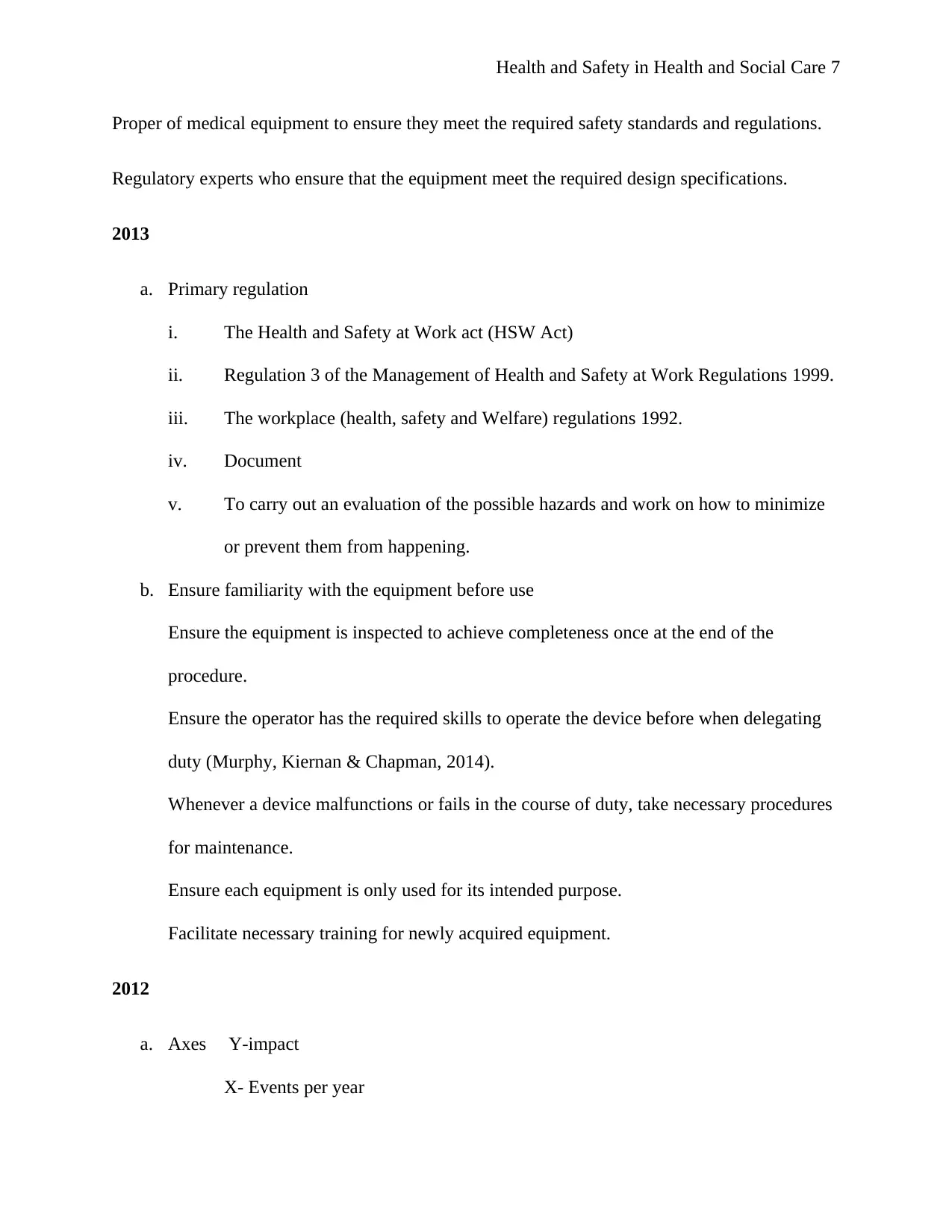
Health and Safety in Health and Social Care 7
Proper of medical equipment to ensure they meet the required safety standards and regulations.
Regulatory experts who ensure that the equipment meet the required design specifications.
2013
a. Primary regulation
i. The Health and Safety at Work act (HSW Act)
ii. Regulation 3 of the Management of Health and Safety at Work Regulations 1999.
iii. The workplace (health, safety and Welfare) regulations 1992.
iv. Document
v. To carry out an evaluation of the possible hazards and work on how to minimize
or prevent them from happening.
b. Ensure familiarity with the equipment before use
Ensure the equipment is inspected to achieve completeness once at the end of the
procedure.
Ensure the operator has the required skills to operate the device before when delegating
duty (Murphy, Kiernan & Chapman, 2014).
Whenever a device malfunctions or fails in the course of duty, take necessary procedures
for maintenance.
Ensure each equipment is only used for its intended purpose.
Facilitate necessary training for newly acquired equipment.
2012
a. Axes Y-impact
X- Events per year
Proper of medical equipment to ensure they meet the required safety standards and regulations.
Regulatory experts who ensure that the equipment meet the required design specifications.
2013
a. Primary regulation
i. The Health and Safety at Work act (HSW Act)
ii. Regulation 3 of the Management of Health and Safety at Work Regulations 1999.
iii. The workplace (health, safety and Welfare) regulations 1992.
iv. Document
v. To carry out an evaluation of the possible hazards and work on how to minimize
or prevent them from happening.
b. Ensure familiarity with the equipment before use
Ensure the equipment is inspected to achieve completeness once at the end of the
procedure.
Ensure the operator has the required skills to operate the device before when delegating
duty (Murphy, Kiernan & Chapman, 2014).
Whenever a device malfunctions or fails in the course of duty, take necessary procedures
for maintenance.
Ensure each equipment is only used for its intended purpose.
Facilitate necessary training for newly acquired equipment.
2012
a. Axes Y-impact
X- Events per year
Paraphrase This Document
Need a fresh take? Get an instant paraphrase of this document with our AI Paraphraser
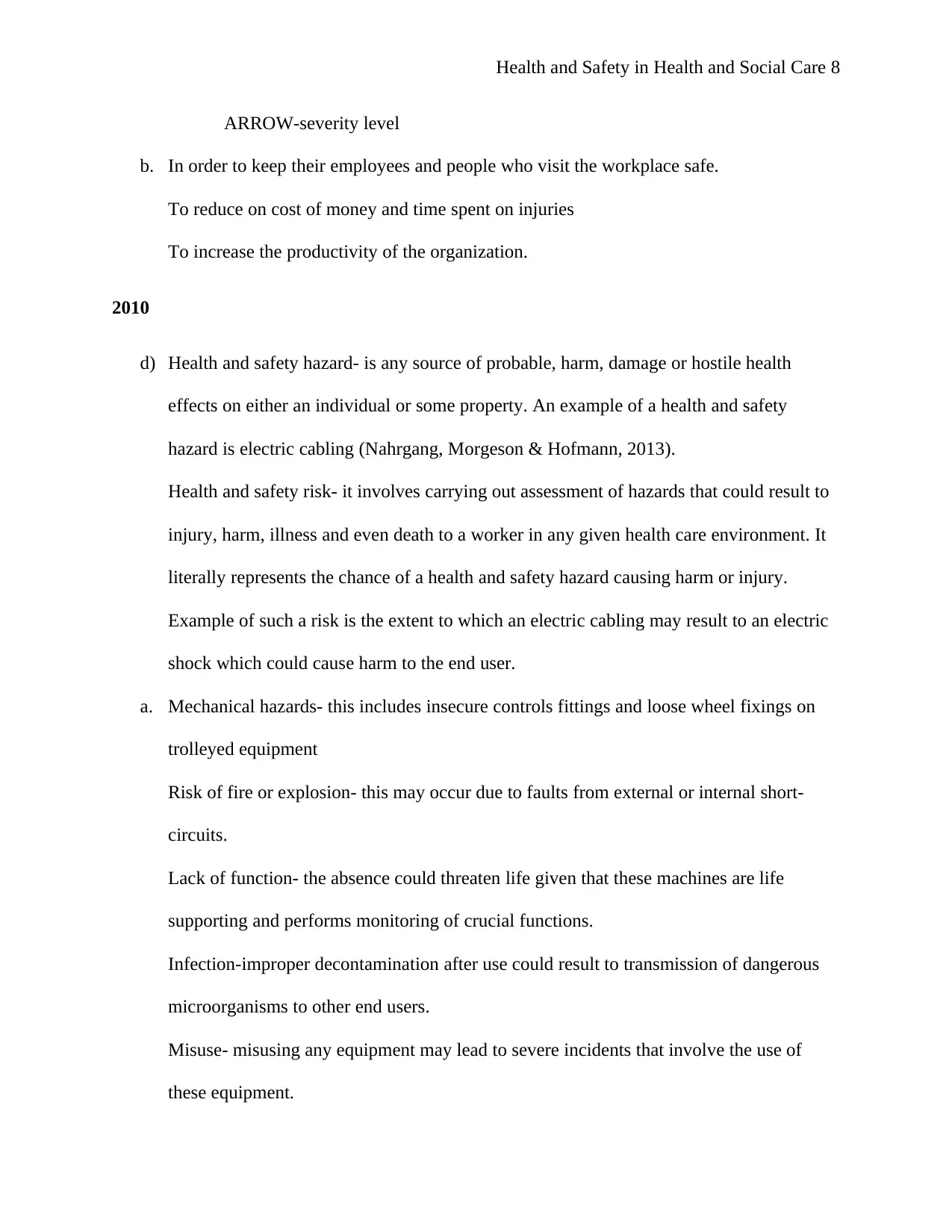
Health and Safety in Health and Social Care 8
ARROW-severity level
b. In order to keep their employees and people who visit the workplace safe.
To reduce on cost of money and time spent on injuries
To increase the productivity of the organization.
2010
d) Health and safety hazard- is any source of probable, harm, damage or hostile health
effects on either an individual or some property. An example of a health and safety
hazard is electric cabling (Nahrgang, Morgeson & Hofmann, 2013).
Health and safety risk- it involves carrying out assessment of hazards that could result to
injury, harm, illness and even death to a worker in any given health care environment. It
literally represents the chance of a health and safety hazard causing harm or injury.
Example of such a risk is the extent to which an electric cabling may result to an electric
shock which could cause harm to the end user.
a. Mechanical hazards- this includes insecure controls fittings and loose wheel fixings on
trolleyed equipment
Risk of fire or explosion- this may occur due to faults from external or internal short-
circuits.
Lack of function- the absence could threaten life given that these machines are life
supporting and performs monitoring of crucial functions.
Infection-improper decontamination after use could result to transmission of dangerous
microorganisms to other end users.
Misuse- misusing any equipment may lead to severe incidents that involve the use of
these equipment.
ARROW-severity level
b. In order to keep their employees and people who visit the workplace safe.
To reduce on cost of money and time spent on injuries
To increase the productivity of the organization.
2010
d) Health and safety hazard- is any source of probable, harm, damage or hostile health
effects on either an individual or some property. An example of a health and safety
hazard is electric cabling (Nahrgang, Morgeson & Hofmann, 2013).
Health and safety risk- it involves carrying out assessment of hazards that could result to
injury, harm, illness and even death to a worker in any given health care environment. It
literally represents the chance of a health and safety hazard causing harm or injury.
Example of such a risk is the extent to which an electric cabling may result to an electric
shock which could cause harm to the end user.
a. Mechanical hazards- this includes insecure controls fittings and loose wheel fixings on
trolleyed equipment
Risk of fire or explosion- this may occur due to faults from external or internal short-
circuits.
Lack of function- the absence could threaten life given that these machines are life
supporting and performs monitoring of crucial functions.
Infection-improper decontamination after use could result to transmission of dangerous
microorganisms to other end users.
Misuse- misusing any equipment may lead to severe incidents that involve the use of
these equipment.
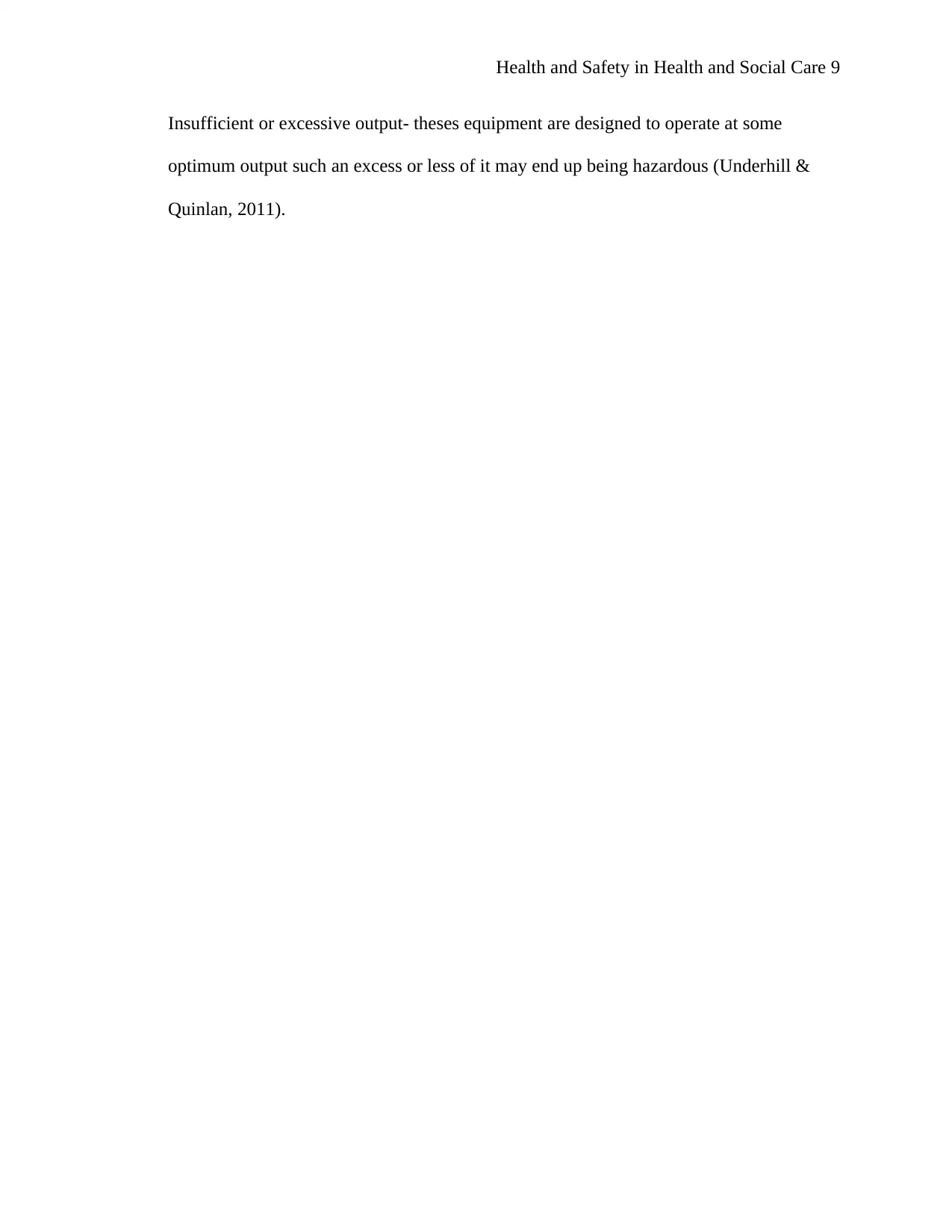
Health and Safety in Health and Social Care 9
Insufficient or excessive output- theses equipment are designed to operate at some
optimum output such an excess or less of it may end up being hazardous (Underhill &
Quinlan, 2011).
Insufficient or excessive output- theses equipment are designed to operate at some
optimum output such an excess or less of it may end up being hazardous (Underhill &
Quinlan, 2011).
⊘ This is a preview!⊘
Do you want full access?
Subscribe today to unlock all pages.

Trusted by 1+ million students worldwide
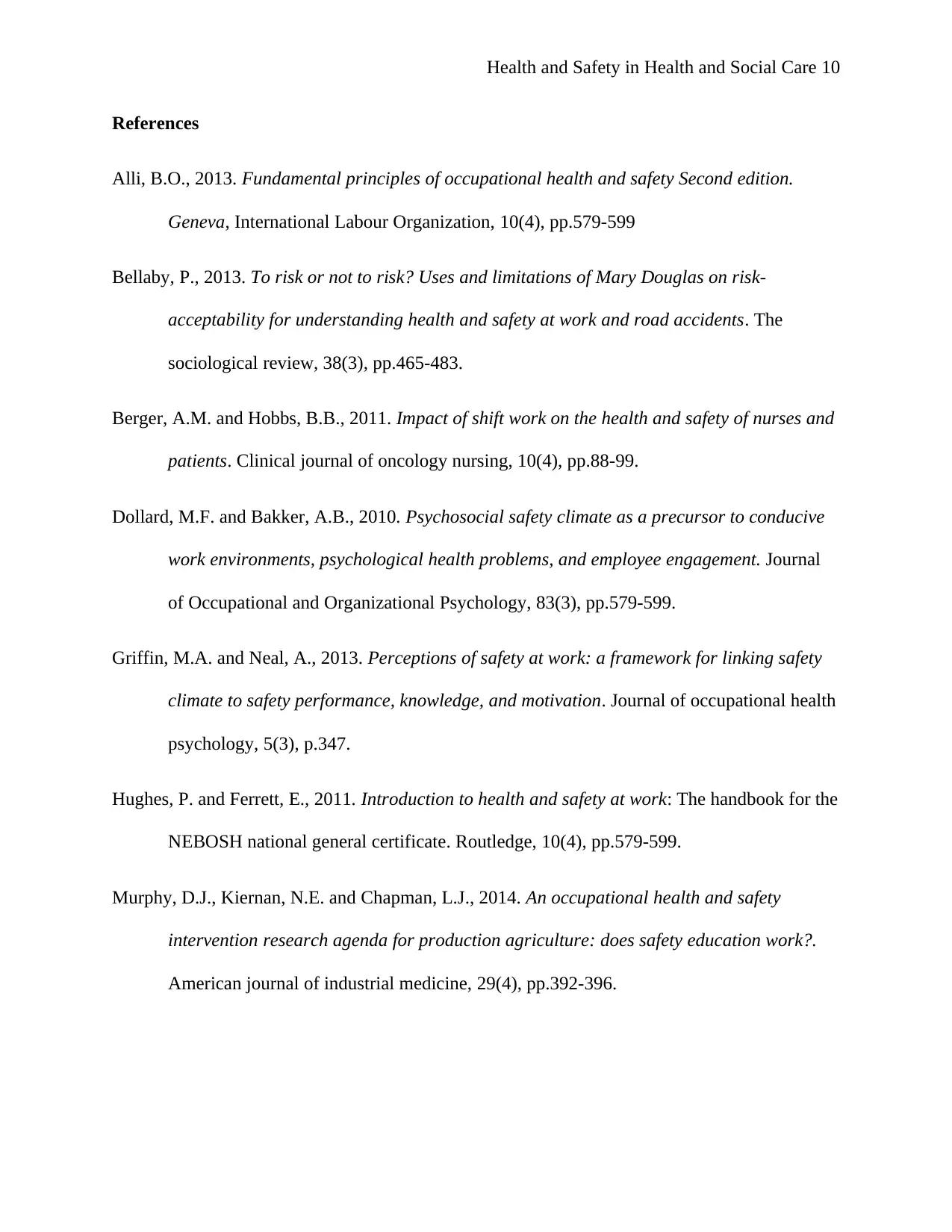
Health and Safety in Health and Social Care 10
References
Alli, B.O., 2013. Fundamental principles of occupational health and safety Second edition.
Geneva, International Labour Organization, 10(4), pp.579-599
Bellaby, P., 2013. To risk or not to risk? Uses and limitations of Mary Douglas on risk-
acceptability for understanding health and safety at work and road accidents. The
sociological review, 38(3), pp.465-483.
Berger, A.M. and Hobbs, B.B., 2011. Impact of shift work on the health and safety of nurses and
patients. Clinical journal of oncology nursing, 10(4), pp.88-99.
Dollard, M.F. and Bakker, A.B., 2010. Psychosocial safety climate as a precursor to conducive
work environments, psychological health problems, and employee engagement. Journal
of Occupational and Organizational Psychology, 83(3), pp.579-599.
Griffin, M.A. and Neal, A., 2013. Perceptions of safety at work: a framework for linking safety
climate to safety performance, knowledge, and motivation. Journal of occupational health
psychology, 5(3), p.347.
Hughes, P. and Ferrett, E., 2011. Introduction to health and safety at work: The handbook for the
NEBOSH national general certificate. Routledge, 10(4), pp.579-599.
Murphy, D.J., Kiernan, N.E. and Chapman, L.J., 2014. An occupational health and safety
intervention research agenda for production agriculture: does safety education work?.
American journal of industrial medicine, 29(4), pp.392-396.
References
Alli, B.O., 2013. Fundamental principles of occupational health and safety Second edition.
Geneva, International Labour Organization, 10(4), pp.579-599
Bellaby, P., 2013. To risk or not to risk? Uses and limitations of Mary Douglas on risk-
acceptability for understanding health and safety at work and road accidents. The
sociological review, 38(3), pp.465-483.
Berger, A.M. and Hobbs, B.B., 2011. Impact of shift work on the health and safety of nurses and
patients. Clinical journal of oncology nursing, 10(4), pp.88-99.
Dollard, M.F. and Bakker, A.B., 2010. Psychosocial safety climate as a precursor to conducive
work environments, psychological health problems, and employee engagement. Journal
of Occupational and Organizational Psychology, 83(3), pp.579-599.
Griffin, M.A. and Neal, A., 2013. Perceptions of safety at work: a framework for linking safety
climate to safety performance, knowledge, and motivation. Journal of occupational health
psychology, 5(3), p.347.
Hughes, P. and Ferrett, E., 2011. Introduction to health and safety at work: The handbook for the
NEBOSH national general certificate. Routledge, 10(4), pp.579-599.
Murphy, D.J., Kiernan, N.E. and Chapman, L.J., 2014. An occupational health and safety
intervention research agenda for production agriculture: does safety education work?.
American journal of industrial medicine, 29(4), pp.392-396.
Paraphrase This Document
Need a fresh take? Get an instant paraphrase of this document with our AI Paraphraser
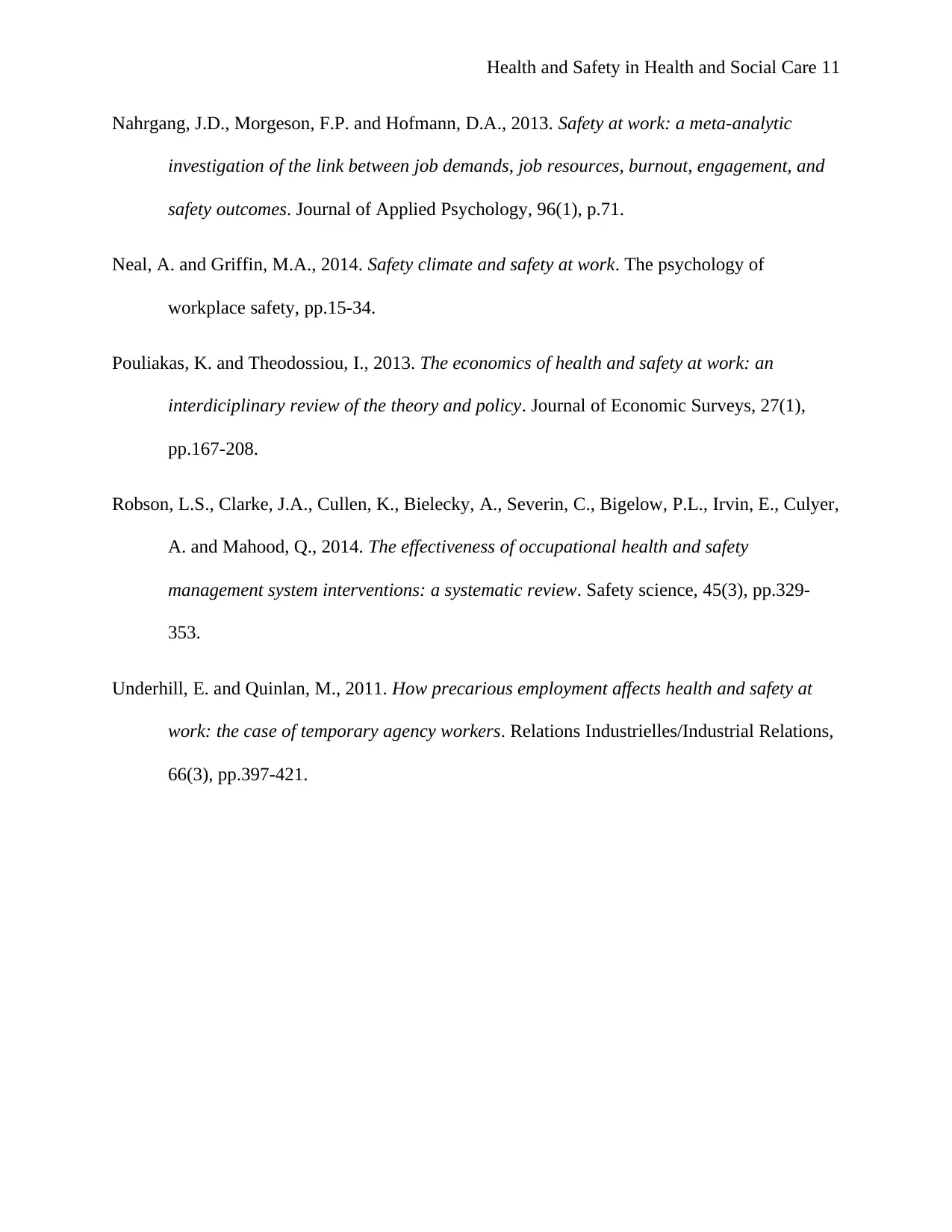
Health and Safety in Health and Social Care 11
Nahrgang, J.D., Morgeson, F.P. and Hofmann, D.A., 2013. Safety at work: a meta-analytic
investigation of the link between job demands, job resources, burnout, engagement, and
safety outcomes. Journal of Applied Psychology, 96(1), p.71.
Neal, A. and Griffin, M.A., 2014. Safety climate and safety at work. The psychology of
workplace safety, pp.15-34.
Pouliakas, K. and Theodossiou, I., 2013. The economics of health and safety at work: an
interdiciplinary review of the theory and policy. Journal of Economic Surveys, 27(1),
pp.167-208.
Robson, L.S., Clarke, J.A., Cullen, K., Bielecky, A., Severin, C., Bigelow, P.L., Irvin, E., Culyer,
A. and Mahood, Q., 2014. The effectiveness of occupational health and safety
management system interventions: a systematic review. Safety science, 45(3), pp.329-
353.
Underhill, E. and Quinlan, M., 2011. How precarious employment affects health and safety at
work: the case of temporary agency workers. Relations Industrielles/Industrial Relations,
66(3), pp.397-421.
Nahrgang, J.D., Morgeson, F.P. and Hofmann, D.A., 2013. Safety at work: a meta-analytic
investigation of the link between job demands, job resources, burnout, engagement, and
safety outcomes. Journal of Applied Psychology, 96(1), p.71.
Neal, A. and Griffin, M.A., 2014. Safety climate and safety at work. The psychology of
workplace safety, pp.15-34.
Pouliakas, K. and Theodossiou, I., 2013. The economics of health and safety at work: an
interdiciplinary review of the theory and policy. Journal of Economic Surveys, 27(1),
pp.167-208.
Robson, L.S., Clarke, J.A., Cullen, K., Bielecky, A., Severin, C., Bigelow, P.L., Irvin, E., Culyer,
A. and Mahood, Q., 2014. The effectiveness of occupational health and safety
management system interventions: a systematic review. Safety science, 45(3), pp.329-
353.
Underhill, E. and Quinlan, M., 2011. How precarious employment affects health and safety at
work: the case of temporary agency workers. Relations Industrielles/Industrial Relations,
66(3), pp.397-421.
1 out of 11
Related Documents
Your All-in-One AI-Powered Toolkit for Academic Success.
+13062052269
info@desklib.com
Available 24*7 on WhatsApp / Email
![[object Object]](/_next/static/media/star-bottom.7253800d.svg)
Unlock your academic potential
© 2024 | Zucol Services PVT LTD | All rights reserved.





